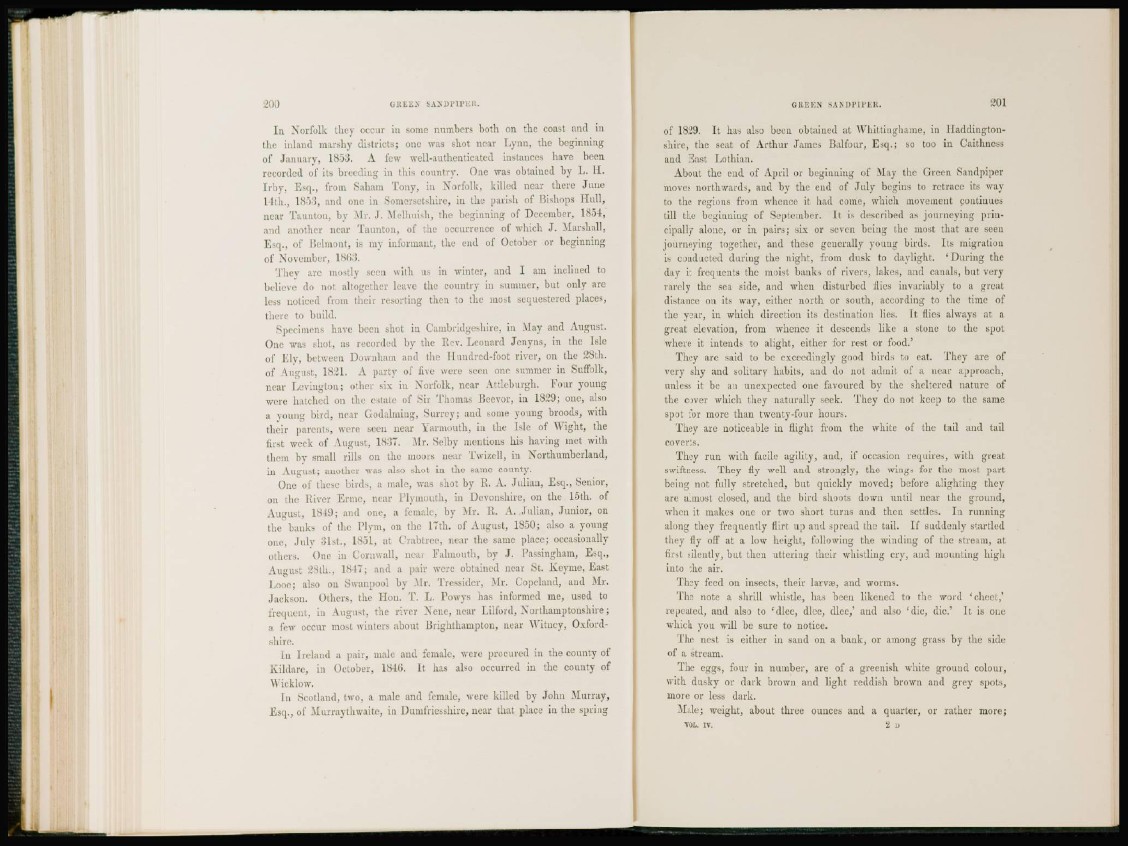
200 GREEN SANDPIPER.
I n Norfolk they occur in some numbers both on the const and in
the inland marshy districts; one was shot near Lynn, the beginning
of January, 1853. A few well-authenticated instances have been
recorded of its breeding in this country. One was obtained by L. IL
I r b y, Esq., from Saham Tony, in Norfolk, killed near there June
1-hh., 1853, and one in Somersetshire, in the parish of Bishops Hull,
near Taunton, by Mr. J. Mclhuish, the beginning of December, 1854,
and another near Taunton, of the occurrence of which J. Marshall,
Esq., of Belmont, is my informant, the end of October or beginning
of November, 1863.
They arc mostly seen with us in winter, and I am inclined to
believe do not altogether leave the country in summer, but only are
less noticed from their resorting then to the most sequestered places,
there to build.
Specimens have been shot in Cambridgeshire, in May and August.
One was shot, as recorded by the Rev. Leonard Jenyns, in the Isle
of Ely, between Downham and the; Hundred-foot river, on the 2Sih.
of August, 1821. A party of five were seen one summer in Suffolk,
near Lcvington; other six in Norfolk, near Attleburgh. Four young
were hatched on the estate of Sir Thomas Bcevor, in 1829; one, also
a young bird, near Godalming, Surrey; and some young broods, with
their parents, were seen near Yarmouth, in the Isle of Wight, the
first week of August, 1837, Mr. Selby mentions his having met with
them by small rills on the moors near Twizcll, in Northumberland,
in August; another was also shot in the same county.
One of these birds, :L male, was shot by It. A. Julian, Esq., Senior,
on the River Ernie, near Plymouth, in Devonshire, on the 15th. of
August, 1849; and one, a female, by Mr. It. A. Julian, Junior, on
the banks of the l'lym, on the 17th. of August, 1850; also a young
one, July 31st., 1851, at Crabtrec, near the same place; occasionally
others. One in Cornwall, near Falmouth, by J. Bassingham, Esq.,
August 28th., 1847; and a pair were obtained near St. Keyme, East
Looe; also on Swanpool by Air. Tressider, Mr. Copcland, and Mr.
Jackson. Others, the Hon. T. L. Powys has informed me, used to
frequent, in August, the river Nenc, near Lilford, Northamptonshire;
a few occur most winters about Brighthamptou, near Witney, Oxfordshire.
In Ireland a pair, male and female, were procured in the county of
Kildare, in October, 1846. It has also occurred in the county of
Wicklow.
In Scotland, two, a male and female, were killed by John Murray,
Esq., of Murraythwaite, in Dumfriesshire, near that place in the spring
GREEN SANDPIPER. 201
of 1829. It has also been obtained at Whittinghame, in Haddingtonshire,
the seat of Arthur James Balfour, Esq.; so too in Caithness
and East Lothian.
About the end of April or beginning of May the Green Sandpiper
moves northwards, and by the end of July begins to retrace its way
to the regions from whence it had come, which movement continues
till the beginning of September. It is described as journeying principally
alone, or in pairs; six or seven being the most that are seen
journeying together, and these generally young birds. Its migration
is conducted during the night, from dusk to daylight. 4 D u r i n g the
day it frequents the moist banks of rivers, lakes, and canals, but very
rarely the sea side, and when disturbed flies invariably to a great
distance on its way, either north or south, according to the time of
the year, in which direction its destination lies. It flies always at a
great elevation, from whence it descends like a stone to the spot
where it intends to alight, either for rest or food.'
They are said to be exceedingly good birds to eat. They are of
very shy and solitary habits, and do not admit of a near approach,
unless it be an unexpected one favoured by the sheltered nature of
the cover which they naturally seek. They do not keep to the same
spot for more than twenty-four hours.
They are noticeable in flight from the white of the tail and tail
coverts.
They run with facile agility, and, if occasion requires, with great
swiftness. They fly well and strongly, the wings for the most part
being not fully stretched, but quickly moved; before alighting they
arc almost closed, and the bird shoots down until near the ground,
when it makes one or two short turns and then settles. In running
along they frequently flirt up and spread the tail. If suddenly startled
they fly off at a low height, following the winding of the stream, at
first silently, but then uttering their whistling cry, and mounting high
into the air.
They feed on insects, their larvae, and worms.
The note a shrill whistle, has been likened to the word 'cheet,'
repeated, aud also to 'dice, dice, dice,' and also 'die, d i e ' It is one
which you will be sure to notice.
The nest is either in sand on a bank, or among grass by the side
of a stream.
The eggs, four in number, are of a greenish white ground colour,
with dusky or dark brown and light reddish brown and grey spots,
more or less dark.
Male; weight, about three ounces and a quarter, or rather more;
vox., iv. 2 it